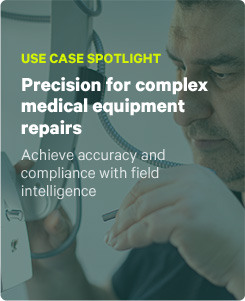When you think about it, it’s not that surprising that so many field service companies are now using mobile inspection software. Whether it’s because of stricter safety rules, higher customer expectations, or more complex assets, field operations are getting more complicated and costlier to manage than ever.
In this blog, we’ll look at the top four benefits of mobile inspection software and how it helps companies make it easier to track, manage, and analyze collected data, which results in a more efficient and effective field service inspection process.
Mobile Inspection Software: Performing the Inspection
When performing audits, mobile inspection software significantly improves audit quality and efficiency. Inspectors can use pre-site visit inspection forms to ensure everything is in working order before beginning. The availability of reports on previously incomplete work, historical inspections, clients, and parts significantly lowers the cost of missed assessments, rescheduled appointments, and penalties for failing to meet SLAs.
The same applies during the inspection. By implementing standard digital forms, you can minimize the effects of inexperience or individual mistakes by guiding inspectors to ensure they perform each evaluation properly. An inspector can also fill out a mobile form more quickly than on paper, even without the added functionality of conditional logic, automated calculations, rich data attachments, and repeatable sections.
Sharing Inspection Data
In today’s world, customer expectations are higher than ever. As a result, field service companies are under more pressure to manage the customer experience and provide greater transparency. Even the slightest miscommunication or delay can mean decreased satisfaction scores and loss of future opportunities.
Here, mobile inspection software helps by allowing you to quickly transmit quality field inspection data between departments—even when technicians are offline. Let’s see this in action. Obayashi’s inspectors had no internet connection when performing safety inspections deep underground for the Crosstown Transit project. Using TrueContext’s offline forms functionality, inspectors could work underground, save their work, and share the data as soon as they reconnected to a network on the surface. Obayashi also eliminated over 30 hours of data entry a month and reduced their incident reporting process from five days to an hour.
Ensuring Compliance
On any inspection, ensuring compliance is of utmost importance. However, that doesn’t mean protecting employees, and keeping up with constantly changing regulations is easy. Mobile inspection software helps with compliance in three significant ways: deployment, recording, and centralization.
With inspection apps, it’s possible to streamline updates across dozens of forms and automatically deploy them to hundreds of employees and subcontractors, ensuring everyone is always up-to-date on the latest safety protocols.
Besides encouraging accountability and transparency, mobile inspection software ensures every audit or inspection has a clear audit trail. This makes determining who carried out which actions during a compliance audit much simpler.
With digitization, you also can be confident that your inspection records are secure, stored, organized, and easily accessible — essential for meeting compliance requirements across different geographic locations.
Mobile Inspection Software: Improved Asset Life Cycle
Today’s field service organizations must meet client expectations and deal with a growing number of increasingly complex assets: a challenge that one of our customers, a global group of energy and petrochemical companies, was quite familiar with.
Their initial processes were paper-based, leading to several problems, including the ineffective management of aging assets. They also had various protocols for each asset, leaving a complex paper trail of audits, inspections, and paperwork.
Thankfully, they overcame these obstacles using mobile inspection software. By making granular inspection and analysis data more accessible, they could finally identify which assets needed immediate attention and justify each decision to repair or replace for maximum operational efficiency.
Conclusion
When you consider all the benefits of mobile inspection software, it’s clear why it’s becoming table stakes in field service organizations across various industries.
Mobile inspection software is more efficient and less expensive than paper-based systems. It can also help organizations improve metrics like first-time fix rates, nuisance calls, and customer satisfaction by bettering the inspection process.




